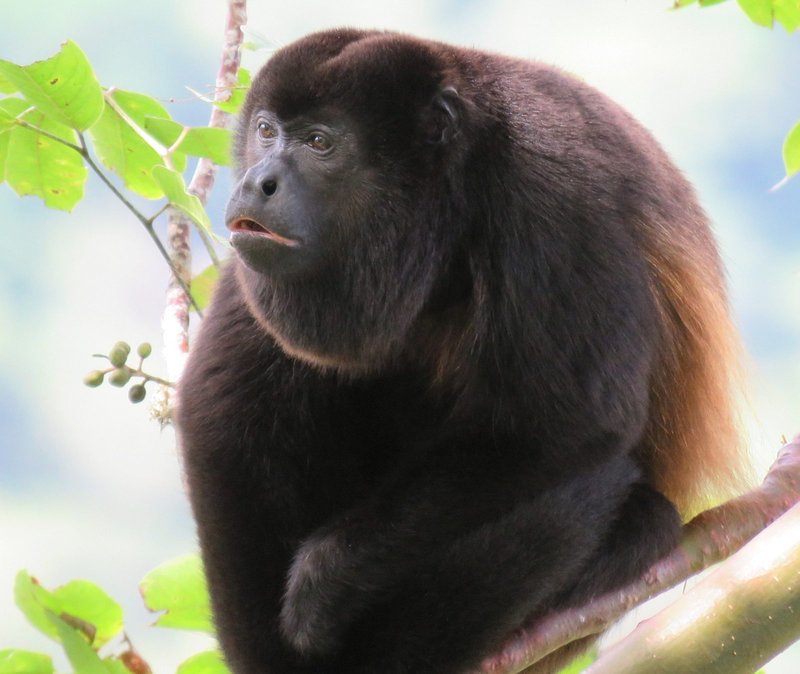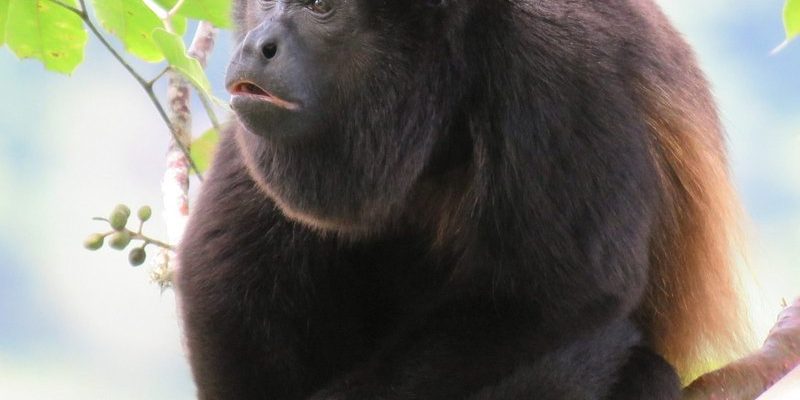
Imagine hearing a deep, echoing sound cutting through the jungle, like a distant thunderstorm rumbling in the background. That’s the call of the Howler Monkey, one of the most fascinating creatures in the animal kingdom. Known for their distinctive vocalizations, these monkeys are often recognized as the loudest land mammals. But there’s much more that makes them stand out beyond their impressive voice.
These unique primates bring a mix of charm and mystery with their striking appearance and social dynamics. Howler monkeys are primarily found in the lush canopies of Central and South America, where their presence adds vibrancy to the biodiversity of rainforest ecosystems. So, what exactly do we know about them? Let’s take a closer look at the life, habitat, and characteristics of these incredible animals.
Physical Characteristics
Howler monkeys are fairly distinctive in appearance. They typically sport long, bushy tails that are often longer than their bodies, which can be quite handy for swinging from branch to branch. Adults can weigh between 15 to 25 pounds, depending on the species, with males generally being larger than females. Their fur can vary but is commonly black, brown, or red, depending on the species. This vibrant coat not only helps them blend into the treetops but also adds to their wild allure.
One of the most iconic features of howler monkeys is their throat sack. This unique adaptation allows them to amplify their vocalizations, making their howls resonate across the forest. When fully inflated, this sack can be quite impressive, almost resembling a balloon. The size of the throat pouch plays a crucial role in determining the volume and depth of their howling, which is essential for communication within their groups.
In terms of anatomy, howler monkeys have long limbs that enable them to move gracefully through the trees. They are excellent climbers and typically use a form of locomotion known as suspensory locomotion, where they hang from branches using their long arms. This style of movement helps them navigate their arboreal environment effectively, staying safe from ground predators and foraging for food.
Habitat and Distribution
Howler monkeys thrive in a variety of habitats, primarily found in tropical rainforests, dry forests, and even deciduous forests in some cases. Their distribution spans across the great expanses of Central and South America—from the rainforests of Costa Rica to the Amazon basin in Brazil. They’re adaptable creatures but tend to favor areas with dense canopy cover, which provides both food sources and safety from predators.
You might be wondering why these monkeys prefer such lush environments. The answer lies in their diet. Howler monkeys are *folivores*; they primarily eat leaves, but they also enjoy fruits, flowers, and occasionally seeds. The abundance of these food sources in their native habitats is critical for their survival. However, it’s important to note that they are selective feeders, choosing leaves that are easily digestible and nutrient-rich.
Unfortunately, habitat loss due to deforestation poses a significant threat to their populations. As trees are cut down for agriculture and urban development, howler monkeys lose both their homes and food sources. Conservation efforts are essential to maintain their habitats and ensure that these magnificent creatures continue to thrive in the wild.
Diet and Feeding Habits
The diet of howler monkeys revolves around a variety of leaves, which can make up about 70% of their intake. Because leaves can be tough to digest and low in calories, howler monkeys have evolved a specialized gut that helps them break down tough plant material. This adaptation is essential, given their reliance on a diet high in foliage. They have to spend a significant amount of their day feeding to meet their energy needs.
Besides leaves, howler monkeys also incorporate fruits into their diet when available. They have been seen foraging for ripened fruits like figs and berries. This adds diversity to their food intake, providing them with essential sugars and nutrients that leaves alone may lack. When it comes to eating, they’re quite selective and often seek out the tastiest morsels available, showing their sophisticated foraging skills.
Social behavior plays a role in their feeding habits as well. Howler monkeys often feed in groups, which can help them keep a lookout for predators while they munch on their leafy meals. This collective behavior also fosters social bonds and communication among members of the troop, making feeding times a significant part of their daily interactions.
Social Structure and Behavior
Howler monkeys are incredibly social animals, often living in family groups that can range from a few individuals to over a dozen. A typical troop consists of a dominant male, several females, and their young offspring. This social structure fosters cooperation, which is crucial for their survival in the wild. The dominant male is usually responsible for protecting the troop and leading their movements through the treetops.
Communication is key in these groups, and howler monkeys have a rich repertoire of vocalizations, body language, and gestures to express themselves. Their distinctive howling serves as a way to establish territory and communicate with other troops. You might hear them howling at dawn or dusk, which adds to the enchanting sounds of the rainforest. It’s fascinating how a simple call can convey so much information about the troop’s location and strength.
The bonds among troop members are strong, particularly between mothers and their young. Female howler monkeys are highly attentive to their offspring, nurturing them for several months after birth. This maternal care ensures that the young learn vital skills needed for survival, from foraging for food to navigating their arboreal environment. The social dynamics within a troop are complex, showcasing the intelligence and emotional depth of these remarkable creatures.
Adaptations and Survival Techniques
Howler monkeys have evolved several unique adaptations that enhance their survival in the wild. Their remarkable vocal abilities are perhaps their most well-known adaptation. The deep howls, which can be heard up to three miles away, not only help define their territory but also act as warnings to potential intruders. This vocalization is a clever way to avoid unnecessary conflicts with neighboring troops, saving energy and minimizing confrontation.
Another adaptation is their physical prowess when it comes to locomotion. Their strong limbs and prehensile tails allow them to move fluidly through the trees, spending most of their lives high above the ground. This arboreal lifestyle keeps them away from ground predators such as jaguars, ocelots, and snakes. Their body structure enables them to grasp branches securely, ensuring they maintain their balance while navigating the forest canopy.
Finally, howler monkeys display a flexible diet that aids in their survival. Being able to consume a variety of leaves and fruits means they can adapt to changes in food availability throughout the year. This dietary adaptability is crucial in the face of habitat changes and competition for resources. Whether it’s shifting their foraging patterns or selecting different types of foliage, howler monkeys demonstrate impressive resilience in their natural environments.
Conservation Status
The conservation status of howler monkeys varies by species, but many face significant threats. Deforestation, habitat fragmentation, and hunting are primary concerns. As their habitats are cleared for agriculture and urban development, these monkeys often become isolated in smaller forest patches, which can lead to genetic inbreeding and population decline.
Conservation organizations are actively working towards preserving howler monkey species through habitat restoration and protection initiatives. These efforts involve collaborating with local communities to promote sustainable land use practices and raise awareness about the importance of preserving natural habitats. Education is key in empowering people to take part in conservation solutions.
You might also find it interesting that some regions have established wildlife corridors to connect fragmented habitats, allowing howler monkeys to move freely and safely between areas. Such steps can significantly enhance their chances of survival in the face of environmental changes. Efforts like these underscore the importance of protecting not just the howler monkeys themselves, but the entire ecosystem they inhabit.
Fun Facts About Howler Monkeys
- Howler monkeys can be spotted swinging through trees, but they can also leap up to 15 feet between branches!
- There are several species of howler monkeys, including the Black Howler, Mantled Howler, and Red Howler, each with unique characteristics.
- These monkeys spend about 70% of their day resting, conserving energy for their active feeding sessions.
- Howler monkeys can live up to 20 years in the wild, but in captivity, they can live even longer, sometimes reaching up to 30 years.
- Because of their distinct calls, howler monkeys have earned the nickname “the loudest primates” in the animal kingdom.
FAQ
What do howler monkeys eat?
Howler monkeys primarily consume leaves, making up about 70% of their diet. They also eat fruits, flowers, and occasionally seeds. This diet is essential for their survival, and they are quite selective about their food choices. Their adaptations allow them to digest tough plant material, giving them an edge in low-calorie environments.
Where do howler monkeys live?
These monkeys generally inhabit tropical rainforests, dry forests, and deciduous forests across Central and South America. They prefer areas with dense canopy cover, which provides ample food sources and shelter from predators.
Are howler monkeys social animals?
Yes, howler monkeys are highly social and typically live in family groups. Their social structure revolves around a dominant male, several females, and their offspring. Communication within these groups is vital, using vocalizations, body language, and gestures to interact.
How loud are howler monkeys?
Howler monkeys are known to be the loudest land mammals, with their calls reaching up to three miles away. Their deep howls serve to establish territory among neighboring troops and facilitate communication within their family groups.
What threats do howler monkeys face?
Howler monkeys are threatened by habitat loss due to deforestation, hunting, and habitat fragmentation. Conservation efforts are crucial for maintaining their populations and protecting their natural habitats.
Do howler monkeys have any predators?
Yes, howler monkeys have several natural predators, including jaguars, ocelots, and large birds of prey. Their primary defense mechanism is to stay high in the trees and use their impressive vocalizations to warn others of potential danger.
How do howler monkeys communicate?
Communication in howler monkeys is multifaceted, involving a variety of vocalizations and gestures. Their signature howls play a significant role in establishing territory and maintaining social bonds, while body language helps convey emotions and intentions within the troop.
Can howler monkeys be kept as pets?
Keeping howler monkeys as pets is not advisable. They are wild animals that require specialized care, social interaction, and a natural habitat to thrive. The complexity of their needs makes them unsuitable as pets, and many places have laws against owning them.
What is the lifespan of howler monkeys?
In the wild, howler monkeys can live up to 20 years, but in captivity, they may live longer due to regular food supply, veterinary care, and protection from predators. However, their quality of life in captivity can vary greatly.
How do howler monkeys reproduce?
Female howler monkeys typically give birth to a single offspring after a gestation period of around 6 months. The mothers are very attentive, often carrying their young for several months until they are ready to explore on their own. Social structures within their groups help to support the upbringing of the young.
Why are howler monkeys important to their ecosystem?
As folivores, howler monkeys play a crucial role in their ecosystem by helping to maintain the balance of plant life. By consuming leaves and fruits, they help with seed dispersal and promote healthy forest regeneration, contributing to the biodiversity of their habitats.
Is there a specific time of year when howler monkeys are more active?
Howler monkeys tend to be more active during the early morning and late afternoon, coinciding with times when the weather is comfortable, and food sources are abundant. Their activity patterns can vary depending on seasonal changes and the availability of food.

